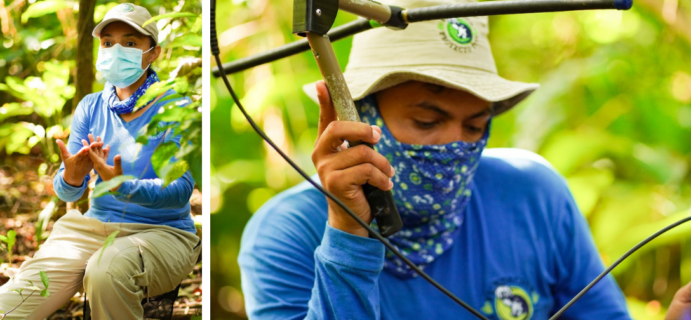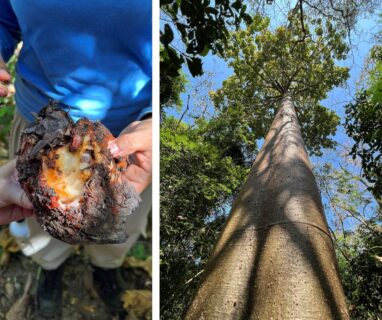Saving the Cotton-Top Tamarin in Colombia
As we get closer to Walk for the Wild, a 5K walk for our wildlife-saving mission, we’re excited to feature one of our many conservation partners, Proyecto Tití, that you help support during our annual 5k walk. This nonprofit works to save the critically endangered cotton-top tamarin in Colombia. If you’ve ever visited the Zoo’s Wortham World of Primates and seen a tiny monkey with a tuft of white fur on its head, that’s a cotton-top!

The cotton-top tamarin – tiny, adorable and critically endangered.
One of the best parts of my job is connecting with all kinds of people – at our Zoo and beyond – to hear inspiring stories of conservation. I was lucky enough to see the work of Proyecto Tití during a trip to visit my partner’s family in Colombia. The research site that we visited is on a privately-owned finca – or farm – in Santa Catalina. Leysthen Diaz, Head of Social Programs, welcomed us to their research base and shared the history of their organization and the cotton-top tamarin.
The cotton-top tamarin (Mono Tití Cabeciblanco in Spanish) weighs just one pound and sports a distinctive tuft of white hair on its head. This tiny tamarin is one of the world’s most endangered primates. Midcentury, an estimated 20,000-40,000 cottontops were trapped and brought to the United States for biomedical research. Fortunately, in 1973 they were listed as Endangered under the US Endangered Species Act, which greatly reduced incidence of capture. Starting in the mid-1980s, Proyecto Tití founder Dr. Anne Savage began doing research on the remaining wild cotton-tops, connecting with Colombians and building a team of passionate conservationists.
The tropical dry forest: a unique, disappearing habitat.
After our history lesson, Leysthen led us through cattle pastures to the edge of a dense forest. The mostly hard, dusty ground along our route is typical in December. This dry season, and following rainy period, creates the unique ecosystem in which the cotton-tops thrive: the tropical dry forest. Right now, the largest threat the tamarins face is loss of this habitat. Historically, over 9 million hectares of tropical dry forest existed in Colombia – today, just 8% remains. The forest continues to shrink due to human activities including agriculture, mining, illegal logging, and urban expansion.
Before entering the forest, our guides advised us to put on insect repellent. Despite the dry season, there were still plenty of mosquitos. This part of Colombia is hot all year round – around 90 degrees and very humid. Every day, researchers head deep into the forest to visit all the family groups and observe their behavior. This site has 11 family groups on which research is done – in each group, one tamarin has a transmitter.

After a few minutes of following the tracker, we caught sight of three cotton-tops in the forest canopy, watching us cautiously. This was the dominant male – who had the transmitter – and the dominant female with a baby. The cotton-tops have a unique hierarchy where the dominant female suppresses the hormones of the other females in the group, so she is the only one to reproduce. Each family group has an incredibly complex social structure and is generally limited to 5-7 individuals. When a group gets too big to sustain, some individuals are forced to leave. Much of what we know about the tamarins’ behavior we learned from the 30+ years of research by team members of Proyecto Tití.
As we made our way back, our guides also showed us something very special – three massive cuipo trees. These trees are fast growing and can reach 150 feet. They drop large chunks of sap, which are a key part of the cotton-top’s diet – especially during the dry season when fruits are hard to come by. We spotted capuchin monkeys, howler monkeys and a pair of scarlet macaws – all part of a delicate ecosystem.

At the end of the tour our guides explained that occasionally, researchers find lone individuals much closer to their base. These cotton-tops have left their family group – a natural process that keeps families at a sustainable size. As Proyecto Tití works to protect larger swaths of forest and to restore forest corridors through reforestation and community education, these cotton-tops will be able to move safely to new habitats and join another family group.

Community Connections
After our tour of the reserve, we visited the nearby village of Los Límites. There, we saw one example of the work Proyecto Tití does with local communities. Proyecto Tití works with people of all ages and backgrounds, from the landowners to farmers to villagers to school children – each of whom can play a role in the cotton-top’s survival.
In our case, we visited local artisans. By empowering artisans to create “eco-mochilas”, a traditional bag used to carry goods, locals increase their income and reuse plastic bags that might otherwise end up as litter. Additional programs with schools help to teach children of all ages about conservation and ways to help protect the cotton-top. And Proyecto Tití works constantly with farmers and landowners to identify forest that can be protected as either a primary habitat, or as a connective corridor.
Support Proyecto Tití – and 32 other partners – at Walk for the Wild.
When you participate in Walk for the Wild on Sunday, April 23, you help support conservation all over the globe, including partners like Proyecto Tití.
